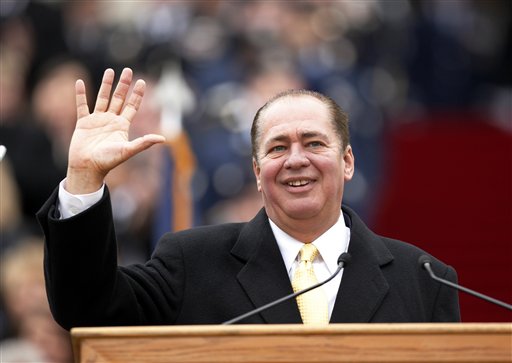Gov. Tomblin and the Clean Power Plan
July 27, 2015 by Ken Ward Jr.
West Virginia Governor Earl Ray Tombin, a Democrat, waves at the conclusion of his inauguration speech on Monday, Jan. 14, 2013, in Charleston, W.Va. (AP Photo/Randy Snyder)
Late last week, the Washington Post’s Joby Warrick had what certainly appeared to be a pretty interesting story with a Hazard, Kentucky, dateline:
Even after years of talk about a “war on coal,” Senate Majority Leader Mitch McConnell startled some of his constituents in March when he urged open rebellion against a White House proposal for cutting pollution from coal-fired power plants.
The Obama administration’s Clean Power Plan is “extremely burdensome and costly,” the Kentucky Republican said in letters advising all 50 states to boycott the rule when it goes into effect this summer.
The call for direct defiance was unusual even for McConnell, who has made a career of battling federal restrictions on coal. Yet more striking is what has happened since: Kentucky’s government and electric utilities have quietly positioned themselves to comply with the rule — something state officials expect to do with relatively little effort.
In this coal-industry bastion, five of the state’s older coal-burning power plants were already scheduled to close or switch to natural gas in the next two years, either because of aging equipment or to save money, state officials say. As a result, Kentucky’s greenhouse-gas emissions are set to plummet 16 percent below where they were in 2012 — within easy reach of the 18 percent reduction goal proposed by the Environmental Protection Agency in a draft of the agency’s controversial carbon-cutting plan.
“We can meet it,” Kentucky Energy and Environment Secretary Leonard Peters, speaking at a climate conference, said of the EPA’s mandate.
The nut graph:
The story is the same across much of the country as the EPA prepares to roll out what is arguably the biggest and most controversial environmental regulation of the Obama presidency. Under the Clean Power Plan, states will have to find ways to achieve dramatic cuts in carbon pollution over the next 15 years, with reduction quotas topping 50 percent over 2012 levels for some states. But despite dire warnings and harsh political rhetoric, many states are already on track to meet their targets, even before the EPA formally announces them, interviews and independent studies show.
Later on, though, a problem cropped up when Joby wrote:
Six governors have taken up McConnell’s call to “just say no” to the EPA’s proposal. Five are Republicans — including presidential contenders Bobby Jindal of Louisiana and Scott Walker of Wisconsin — and one, Earl Ray Tomblin of West Virginia, is a Democrat.
The Gazette-Mail’s David Gutman pointed this out, and noted he didn’t recall Gov. Tomblin actually going along — at least publicly — with Sen. McConnell’s plan. So I checked in with the governor’s communications officer, Chris Stadelman. And sure enough, Chris told me in an email message that Gov. Tomblin “has not made a final decision” on Sen. McConnell’s proposal but “will do what’s in the best interest of WV residents.”
Unfortunately, a case of the right hand not knowing what the left hand was doing resulted in the Post story being published (through the paper’s wire service) on the Sunday Gazette-Mail business page. We ran a correction this morning.
Now it’s not like there hasn’t been some political pressure on the governor about this. Last month, West Virginia’s three House members — Republican Reps. David McKinley, Alex Mooney and Evan Jenkins, wrote to Gov. Tomblin to urge him to “just say no” by not submitting a state compliance plan once EPA finalizes its carbon pollution rule for power plants.
But it’s also not as if Gov. Tomblin has embraced the EPA proposal. The day it was announced, the governor hosted a press conference at the Capitol to ensure that West Virginia media coverage focused on opposition to EPA’s proposal. In a prepared statement, Gov. Tomblin said that day:
The EPA’s new rules are an extensive 645 pages long and at first glance, there are several proposals that cause us great concern. If these rules are put into place, our manufacturers may be forced to look overseas for more reasonable energy costs, taking good paying jobs with them and leaving hardworking West Virginians without jobs to support their families. We must make every effort to create opportunities for our young people, not hinder them.
What’s more, it’s not like Gov. Tomblin has been publicly championing the efforts of folks like the WVU College of Law’s Center for Energy and Sustainable Development and the Morgantown-based consulting firm Downstream Strategies to find a clear path for West Virginia to comply with the EPA Clean Power Plan (see here and here).
Instead, the state Department of Environmental Protection submitted lengthy comments against the EPA rule, and the governor went to Pittsburgh to rally with coal miners against the EPA proposal (see here and here), saying:
Growing up in the heart of coal country and as a proud son of the West Virginia coalfields, who continues to make his home there, I see the faces behind these numbers. When the EPA forces mines to close, I know the men and women who lose their jobs, the families who are at risk of losing their homes and the sons and daughters forced to move away to find work.
Those West Virginians are the real reason I continue to stand up to the EPA – to be their voice and share their struggles with those who need to hear them. We can and must do better for our communities and our families.

 Subscribe to the Coal Tattoo
Subscribe to the Coal Tattoo
